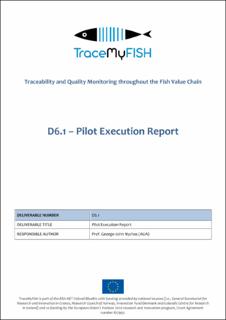| dc.description.abstract | This deliverable provides a preliminary report on the first's pilot experimental design and on the acquired data. In addition, a first evaluation of the VIDEOM multispectral imaging sensor in terms of its application on the specific types of fish and on its actual application along the fish chain and the identified critical points in this chain (functionality, operational conditions etc.). Thus, towards this scope and in the general concept of WP6, the corresponding partners (AUA, NTNU, UoI and MATIS), define and set up the experimental conditions of each of the three pilots and acquire the measurement using the VIDEOM provided sensor. The collected data will serve as inputs for further use and analysis, i.e. machine learning model training and deployment.
In Task 6.1, to which this deliverable accounts for, AUA, NTNU, UoI and MATIS will perform measurements with the provided by VIDEOM sensor on domestic fish samples, specifically 3 types of fish: Atlantic salmon, Atlantic whitefish, and Mediterranean seabream/seabass. The measurements are performed in a way that simulates the real food chain so as to evaluate the sensor in tandem with the hazard/quality detection algorithms that will be developed according to the initial experiment design for the 3 pilots as outlined in D2.3. Initially, a first round of measurements has been applied in order to ensure and compensate any field variations reflected on the data.
Those data will further be used for the training of the prediction/detection models to be developed. Then, additional measurements will be performed for system validation purposes along the whole food chain, resulting in the creation of a database, so as to reproduce the results and compare the final algorithms and analytics approaches in order to ensure the efficiency and robustness in terms of future application and traceability of any erroneous predictions. It should be mentioned that all measurements are backed up by simultaneously acquired reference measurements coming from conventional/traditional microbiological and/or chemical methods. Those reference measurements serve as the "ground truth" for system validation and evaluation in Task6.2 with the participation of VIDEOM, where the evaluation will be on a specific KPIs set; the accuracy on the determination of sample properties like colour, texture, surface chemistry, contamination, oxidation, species and/or parasites, all this in conjunction to the "ground truth" as provided by lab analyses; Also, the traceability efficiency will be validated across the food chain, knowing the "real" sample properties. | en_US |
